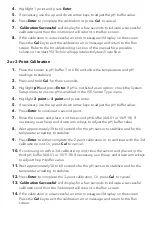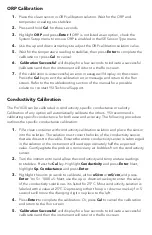
Pro
1030
Quick Start Guide
Item #605183
This Quick Start Guide is meant to serve as a quick reference in calibrating and
operating the Pro1030. It is not intended to replace the information found in the User
Manual.
Installing the pH or ORP Sensor
Prior to use, install either a Pro Series pH, pH-amplified or ORP sensor. Failure to install
a pH or ORP sensor may cause permanent damage to the cable not covered under
warranty.
1.
Remove the temporary plastic plug from the cable’s port by pulling it straight
out of the port. This can be discarded.
2.
Remove the plastic plug from the sensor’s connector by pulling it straight off the
sensor. This can be discarded.
3.
Ensure both the sensor connector and cable connector are clean and dry.
4.
Grasp the sensor with one hand and the cable bulkhead in the other.
5.
Push the sensor into the connector on the cable until it is firmly seated and only
1 o-ring is visible. Failure to properly seat the sensor may result in damage.
6.
Twist the sensor clockwise to engage the threads and finger tighten. Do NOT
use a tool. This connection is water-tight.
7.
You may remove the shipping storage vessel from the sensing end of the
sensor. This can be saved for later use when storing the sensor for long periods
of time. For short term storage (<30 days), place the probe in the grey storage
sleeve with a sponge moistened with tap water.
pH Calibration
The Pro1030 pH sensor can be calibrated by performing a 1, 2 or 3-point calibration. At
least one of the calibration points must be done with pH buffer 7 or 6.86. For highest
accuracy, perform at least a 2-point calibration.
1 Point Calibration
1.
Place the sensor in pH buffer 7 or 6.86 and allow the temperature and pH
readings to stabilize.
2.
Press and hold
Cal
for three seconds.
3.
Highlight
pH
and press
Enter
. If pH is not listed as an option, check the System
Setup menu to ensure pH is enabled in the ISE Sensor Type menu.






















